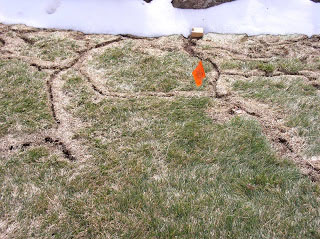Adapted by Deryn Davidson, Boulder County Extension, from the CO-Horts blog originally authored by Irene Shonle, Gilpin County Extension.
 Voles trails become apparent in the melting snow |
Once snow begins to melt off lawns, people begin looking in horror at the trails all over their lawns, and perhaps also looking at dead junipers or other shrubs from the voles girdling action. High vole numbers may be due to high moisture the previous year(s). It causes a lot of grasses and forbs to grow luxuriantly, and can lead to lots of fat and happy voles that have lots of successful litters.
The good news here is that voles have pretty predictable boom and bust cycles. Population explosions are followed by intense predation and other stressors that bring the levels back down. So, even if you do nothing, you will probably find fewer voles in the future. And it may bring a little comfort to realize how ecologically important the voles are – coyotes, fox, bobcats and hawks all depend on them. In other words, we would never wish them to go away altogether. And for that matter, they never WILL go away altogether. If you have voles now, you probably will get voles again.
To repair damage to lawns from runway construction, rake, fertilize and water the affected area. The lawn should recover when the grass begins to grow. Extensive areas may need reseeding.
For the most part, trapping is the fastest way to handle voles, and has the least potential to cause secondary environmental damage. It can seem daunting, but it is pretty easy to trap down the population that has settled in your yard in just a couple of days. Poisons can be used, but there is the possibility of secondary poisoning of all the critters that could then eat the poisoned vole (including your dog or cat). For more information on how to trap or use toxicants, please see: http://extension.colostate.edu/topic-areas/natural-resources/managing-voles-in-colorado-6-507/
In the fall, mow your lawn closely to reduce the tall grass that provides a safe haven for voles. Since they are food for so many species, voles are cautious in exposing themselves unnecessarily. If you live near an open space area, see if there is a way to mow a swath of the native grasses along the fence line to keep them from crossing over into adjacent lawns.
If you’re not sure whether you have voles or not, take a look at this fact sheet that helps identify what animal caused the damage you see in your lawn: http://extension.colostate.edu/topic-areas/natural-resources/burrowing-animals-determining-species-by-burrows-damage-6-521/
For more information, see the following Planttalk Colorado™ video(s).



